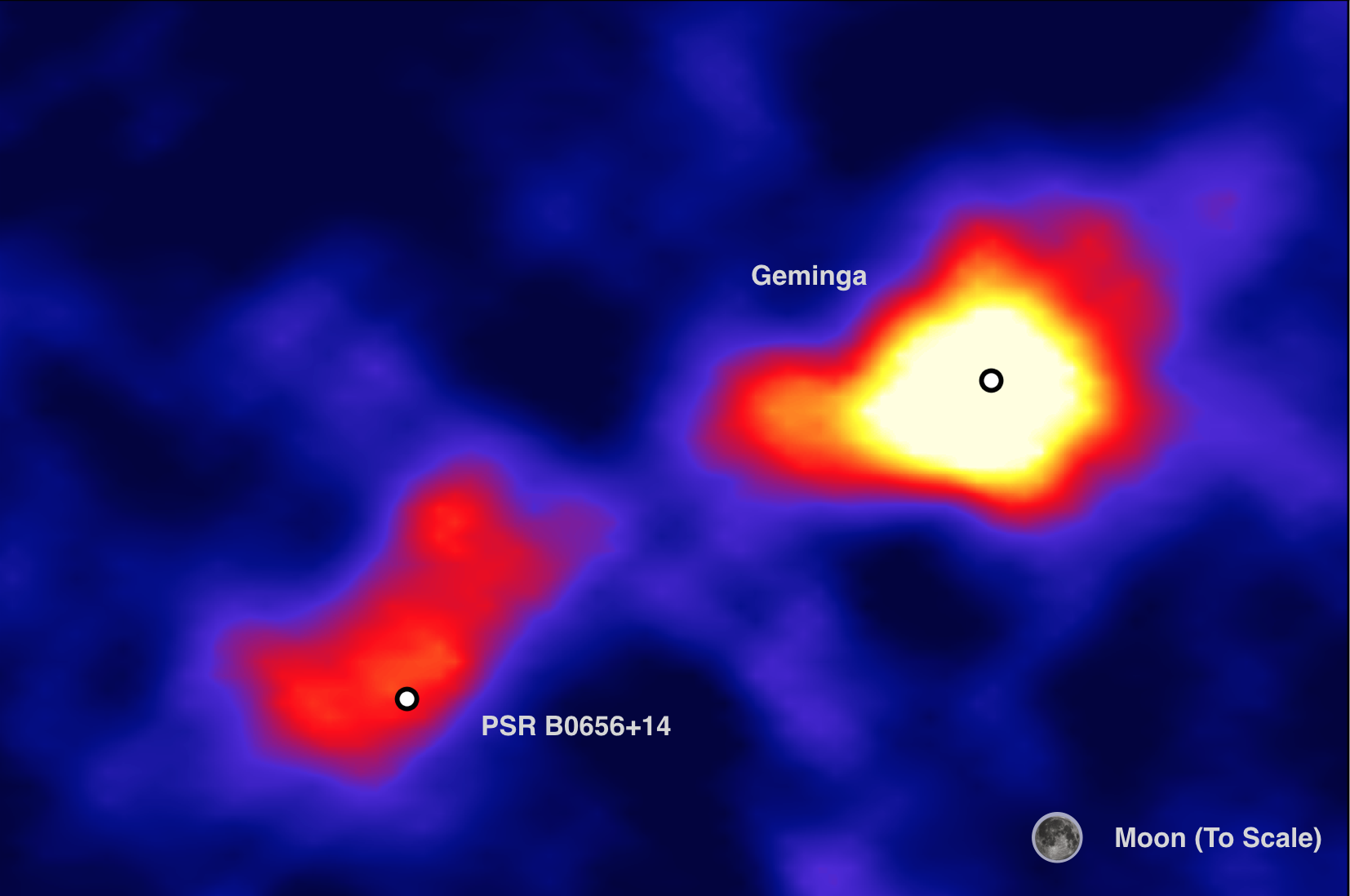The High-Altitude Water Cherenkov Gamma-Ray Observatory (HAWC) has captured the first wide-angle view of very high energy light emanating from two rapidly spinning neutron stars, Geminga and PSR B0656+14. This measurement has given a fresh perspective on these stellar neighbors that casts serious doubt on one possible origin for a mysterious excess of particles near Earth that has tantalized scientists in recent years. Located on the slopes of Mexico’s highest mountain, HAWC was built and is operated by an international team of scientists in Mexico, the U.S., and Europe, including an active group at the University of Wisconsin–Madison.
In 2008, a spaceborne detector, AMS-02, measured an unexpectedly high number of positrons—the antimatter cousins of electrons—near Earth. Since then, scientists have debated the cause of the anomaly. Some have speculated that the extra positrons have an exotic origin, perhaps coming from as yet undetected processes involving dark matter—an invisible but pervasive substance seen only through its gravitational pull. Others have suggested something more mundane: The extra particles might be coming from nearby collapsed stars called pulsars that spin around several times a second and throw off electrons, positrons, and other matter with violent force.
Now, using new data from HAWC, a collaboration of researchers has made the first detailed measurements of two pulsars touted as possible sources of the positron excess. By catching and counting particles of light streaming forth from these nearby stellar engines, the HAWC Collaboration has showed that these two pulsars are very unlikely to be the origin of the excess—despite being the right age and the right distance from Earth to contribute. Positrons from these sources simply haven’t spread far enough to reach Earth in sufficient numbers. The results are published today in Science.

The HAWC observatory sits at an elevation of 13,500 feet, flanking the Sierra Negra volcano inside Pico de Orizaba National Park in the Mexican state of Puebla. It consists of more than 300 massive water tanks that observe cascades of particles initiated by high-energy packets of light called gamma rays—many of which have more than a million times the energy of a dental X-ray. The UW–Madison team at WIPAC, led by Prof. Stefan Westerhoff, is a longtime contributor to this novel gamma-ray telescope, in which they have participated with a vast range of activities, from detector design and tank construction to current analyses of the cosmic-ray anisotropy and searches for flaring activity in astrophysical sources.
When gamma rays smash into the upper atmosphere, they blast apart atoms in the air, producing a shower of particles that moves at nearly the speed of light toward the ground. When this shower reaches HAWC’s tanks, it produces coordinated flashes of blue light in the water, allowing researchers to reconstruct the energy and cosmic origin of the gamma ray that kicked off the cascade.
Collecting many gamma rays from the same region of the sky allows HAWC to build sharp images of individual gamma-ray sources. The highest energy photons originate in the graveyards of big stars, such as the spinning pulsar remnants of supernovae. But that light doesn’t come from the stars themselves. Instead, it’s created when electrons or positrons are accelerated to extremely high energies by the spinning star and smash into lower-energy photons left over from the early universe.
The size of this stellar debris field, measured by the patch of sky that glows bright in gamma rays, tells researchers about how quickly matter moves relative to a local astrophysical engine—in this case, the nearby pulsar. This, in turn, enables researchers to estimate how many positrons could have reached Earth from the source. Using the most complete catalog of HAWC data to date, scientists have absolved the nearby pulsar Geminga and its neighbor as sources of the positron excess at Earth. Even though the two pulsars are old enough and close enough to account for the excess, matter isn’t drifting away from the pulsars fast enough to have reached Earth.
This measurement has been possible thanks to HAWC’s wide view—about one third of the sky overhead, which provided researchers with a broad picture of the space around the pulsars. Other observatories watching for very high energy gamma rays have a much narrower field of view and miss the extended nature of the pulsars.
“Like its predecessor Milagro, HAWC with its wide field of view is the ideal instrument to measure very high energy gamma ray profiles caused by the particle diffusion around nearby pulsars. HAWC’s sensitivity, however, is more than ten times better than Milagro’s, so we now have a much clearer picture,” says Tom Weisgarber, an assistant scientist in the UW–Madison HAWC group.
It’s possible that a new insight into the astrophysics of these pulsars and their local environments could account for the positron excess at Earth, but it would require a more complicated theory than physicists think is likely. If the extra positrons do actually originate from dark matter, which many researchers think might be the case, HAWC may be able to spot the gamma-ray glow of these dark matter processes directly.
In addition to Westerhoff and Weisgarber, the members of the UW–Madison HAWC group are Research Professor Mike DuVernois, postdoc Joshua Wood, and graduate students Juan Carlos Diaz Velez and Brad Kumm.
This work was supported by the US National Science Foundation (NSF); the US Department of Energy (DOE) Office of High-Energy Physics; the Laboratory Directed Research and Development program of Los Alamos National Laboratory (LANL); and the Mexican National Council of Science and Technology (CONACyT). It is also supported by the Wisconsin Alumni Research Foundation.
+ info “Extended gamma-ray sources around pulsars constrain the origin of the positron flux at Earth,” A.U. Abeysekara et al., Science 358 (2017). DOI: 10.1126/science.aan4880
